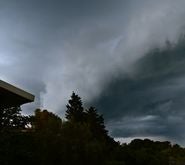The annual damage from European windstorms can range significantly: from years when there are clusters of severely damaging storms to other years with almost no windstorm loss. How much of this volatility can we predict, and how much remains a roll of the dice? And more specifically, what storm activity can we expect over the next few months?
Forecasting Storminess
Our understanding of the drivers of annual storminess has increased greatly in recent years, allowing us to provide more forecasting insight than ever before. However, there is a cautionary tale for the industry, one that shows the limitations of even the most sophisticated seasonal forecasts.
The Atlantic Multidecadal Oscillation (AMO) is a pattern of long-duration variability in sea surface temperature in the North Atlantic. It is known to influence the climate over much of the northern hemisphere including the level of storminess in Europe1. As north-south gradients of heat in the Atlantic act to fuel extra-tropical storms2 these longer term changes in sea surface temperature tend to alter the odds of extreme storm occurrence over timescales of 60-80 years. Today, the ongoing positive (warm) phase of the AMO favors lower than average storminess this winter.
That’s the multi-decadal perspective. But it will come as no surprise for Europeans to hear that as well as these longer phases of relative activity and inactivity, the continent also experiences variability of storminess from year to year. We know that the jet stream is a main ingredient of storms, and that in turn these storms strengthen the jet itself, in a positive feedback loop that leads to the term “eddy-driven jet.” This “storms-beget-storms” mechanism typically plays out over a few weeks, and more severe storms are likelier to occur during these periods. The positive feedback between jet and storms amplifies swings in annual damage, and explains a substantial amount of the storm clustering found in longer range historical weather records4. This coupling between storms and jet is reflected in the version 16.0 of the RMS Europe Windstorm Clustering Model.
Researchers have identified various drivers of seasonal storminess in the North Atlantic which, for the coming winter, are ambiguous. For instance: we are three years after the peak of a prolonged but subdued solar cycle and this timing suggestsless forcing of storminess. But in contrast the predictions are for neutral to weak La Niña phases of the El Niño–Southern Oscillation (ENSO) which points to a chance of increased forcing of North Atlantic storminess. Whilst, to complicate things further, the anticipated values of tropical stratosphere winds, linked to the Quasi-Biennial Oscillation (QBO), are related to less storminess in the mid-latitude Atlantic – with the caveat that they are in an unusually disrupted pattern.
So is it possible to get off the meteorological fence and make a call? Yes: overall, the multi-decadal and seasonal drivers indicate slightly below average storminess.
Severe Events Can Occur During Any Season
But this does not mean that we as an industry should be entirely relaxed about the new storm season, as the outlook for annual storm damage is blurred by the vagaries of local weather. This is exemplified by storm Kyrill in January 2007.
Then, ahead of the 2006/07 winter, the seasonal and multi-decadal drivers indicated below average storminess, just as they do today. But Kyrill occurred and turned an otherwise innocuous season into a bad one for many. The gusts and damage during this storm were much more extreme than its general circulation, because convection cells embedded in the cold front contributed to extreme damage intensity in some areas5. Storm Kyrill showed how processes on small space and time scales can dominate annual storm damage. These drivers have seriously short predictability windows of just a few hours.
More generally, some of the past variations in annual storminess have no known driver. We are not quite sure how much, but a reasonable ball-park figure is one half. This random part is found in climate models, where the tiniest possible changes at the start of a forecast often grow into large changes in seasonal average storminess.
Although our understanding of the drivers of storminess has greatly increased over the past few years and the odds do favor less storm damage this winter, we should not be complacent. As its tenth anniversary approaches, Storm Kyrill reminds us that major losses can happen in any season, regardless of the forecast.
Web links to references above
1Peings and Magnusdottir (2014) [ http://iopscience.iop.org/article/10.1088/1748-9326/9/3/034018/pdf ]
2Shaffrey and Sutton (2006) [ http://journals.ametsoc.org/doi/pdf/10.1175/JCLI3652.1 ]
3NOAA ESRL AMO data [http://www.esrl.noaa.gov/psd/data/timeseries/AMO/ ]
4Cusack (2016) [ http://www.nat-hazards-earth-syst-sci.net/16/901/2016/nhess-16-901-2016.pdf ]
5Fink et al. (2009) [ http://centaur.reading.ac.uk/32783/1/nhess-9-405-2009.pdf ]
This post was co-authored by Peter Holland and Stephen Cusack.






